My suggestion is to first make use of some good ol oop design. Create a simple bean like CurrentPrevious where you can hold the value of the current and previous values. Add those instances of CurrentPrevious to the table model.
class CurrentPrevious {
Double current;
Double previous;
// getters an setters
@Override
public String toString() {
return current.toString();
}
}
You only want the current value to be viewed in the table, so you can simply override the toString of the class and return the string value of current.
As for the rendering, you don't need a custom render. I don't see you doing anything special with it. Creating a text field as the renderer seems pointless. Any desired editing functionality should be done with the editor component. So instead of the custom renderer, just override prepareRenderer of the table. Something like below:
@Override
public Component prepareRenderer(TableCellRenderer renderer, int row, int col) {
Component c = super.prepareRenderer(renderer, row, col);
Object value = getValueAt(row, col);
if (value instanceof CurrentPrevious) {
CurrentPrevious curPrev = (CurrentPrevious) value;
Double current = curPrev.getCurrent();
Double previous = curPrev.getPrevious();
Color color = getColor(current, previous);
c.setBackground(color);
}
return c;
}
...
private Color getColor(Double current, Double previous) {
Color color;
if (current.equals(previous) || current > previous) {
color = Color.GREEN;
} else {
color = Color.RED;
}
return color;
}
When the value needs to be updated, just change the value of the previous to the current, and set the current to the new value.
DefaultTableModel model = (DefaultTableModel) table.getModel();
for (int i = 0; i < model.getRowCount(); i++) {
CurrentPrevious curPrev = (CurrentPrevious) model.getValueAt(i, 0);
curPrev.setPrevious(curPrev.getCurrent());
Double newCurrent = getRandomDouble();
curPrev.setCurrent(newCurrent);
model.setValueAt(curPrev, i, 0);
}
The result would look something like:

import java.awt.Color;
import java.awt.Component;
import java.awt.Dimension;
import java.awt.event.ActionEvent;
import java.awt.event.ActionListener;
import java.math.BigDecimal;
import java.math.RoundingMode;
import java.util.Random;
import javax.swing.JFrame;
import javax.swing.JScrollPane;
import javax.swing.JTable;
import javax.swing.SwingUtilities;
import javax.swing.Timer;
import javax.swing.table.DefaultTableModel;
import javax.swing.table.TableCellRenderer;
import javax.swing.table.TableModel;
public class ChangeCellColorDemo {
private Random random = new Random();
private JTable table = getTable();
public ChangeCellColorDemo() {
Timer timer = new Timer(2000, new TimerListener());
JFrame frame = new JFrame();
frame.add(new JScrollPane(table));
frame.pack();
frame.setDefaultCloseOperation(JFrame.EXIT_ON_CLOSE);
frame.setLocationRelativeTo(null);
frame.setVisible(true);
timer.start();
}
private class TimerListener implements ActionListener {
@Override
public void actionPerformed(ActionEvent e) {
DefaultTableModel model = (DefaultTableModel) table.getModel();
for (int i = 0; i < model.getRowCount(); i++) {
CurrentPrevious curPrev = (CurrentPrevious) model.getValueAt(i, 0);
curPrev.setPrevious(curPrev.getCurrent());
Double newCurrent = getRandomDouble();
curPrev.setCurrent(newCurrent);
model.setValueAt(curPrev, i, 0);
}
}
}
private JTable getTable() {
JTable table = new JTable(getTableModel()) {
@Override
public Component prepareRenderer(TableCellRenderer renderer, int row, int col) {
Component c = super.prepareRenderer(renderer, row, col);
Object value = getValueAt(row, col);
if (value instanceof CurrentPrevious) {
CurrentPrevious curPrev = (CurrentPrevious) value;
Double current = curPrev.getCurrent();
Double previous = curPrev.getPrevious();
Color color = getColor(current, previous);
c.setBackground(color);
}
return c;
}
@Override
public Dimension getPreferredScrollableViewportSize() {
return getPreferredSize();
}
};
return table;
}
private TableModel getTableModel() {
String[] cols = {"Value"};
DefaultTableModel model = new DefaultTableModel(cols, 0);
for (int i = 0; i < 10; i++) {
Object[] row = new Object[1];
Double current = getRandomDouble();
Double previous = getRandomDouble();
row[0] = new CurrentPrevious(current, previous);
model.addRow(row);
}
System.out.println(model.getRowCount());
return model;
}
private Color getColor(Double current, Double previous) {
Color color;
if (current.equals(previous) || current > previous) {
color = Color.GREEN;
} else {
color = Color.RED;
}
return color;
}
private Double getRandomDouble() {
BigDecimal bd = new BigDecimal(random.nextDouble());
bd = bd.setScale(4, RoundingMode.HALF_UP);
return bd.doubleValue();
}
class CurrentPrevious {
Double current;
Double previous;
public CurrentPrevious() {}
public CurrentPrevious(Double current, Double previous) {
this.current = current;
this.previous = previous;
}
public Double getCurrent() {
return current;
}
public Double getPrevious() {
return previous;
}
public void setCurrent(Double current) {
this.current = current;
}
public void setPrevious(Double previous) {
this.previous = previous;
}
@Override
public String toString() {
return current.toString();
}
}
public static void main(String[] args) {
SwingUtilities.invokeLater(new Runnable() {
public void run() {
new ChangeCellColorDemo();
}
});
}
}
